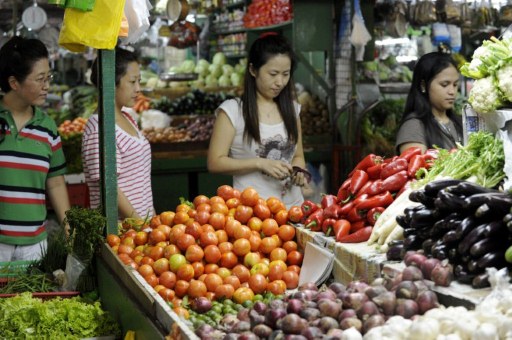Inflation seen to remain within target this year

Customers buy vegetables in Manila’s farmers market in this file photo. Consumer price increases in the country will likely remain muted this year despite the impact of recent floods, according to New York-based think tank Global Source. AFP PHOTO/JAY DIRECTO
MANILA, Philippines—Consumer price increases in the country will likely remain muted this year despite the impact of recent floods, but a less benign inflation environment looms in 2013 as global oil and food prices are starting to trend higher, according to New York-based think tank Global Source.
In a commentary dated August 14 titled “Rainy Days,” it said monetary authorities might be forced to hold off from further monetary easing, “although they may still try to sneak in one more policy cut before the year ends.”
The report, written by Filipino economists Romeo Bernardo and Margarita Gonzales, said the main motivation for the recent cut in the Bangko Sentral ng Pilipinas’ overnight borrowing rate to a new record low of 3.75 percent was to avert further speculative play on the peso and ease pressure on the central bank’s balance sheet rather than to prevent a potential growth slowdown.
The research said the country’s inflation rate this year might settle at the lower end of the 3-5 percent range of the Bangko Sentral ng Pilipinas despite supply shocks from the recent floods.
Global Source said the destruction caused by the flooding so far—equivalent to about 0.02 percent of gross domestic product—did not seem large enough to affect its growth outlook for the year. The think tank expects Philippine GDP to grow at least 4.5 percent this year.
“The cost hardly compares to that of the last great flood brought on by tropical storm Ondoy in late September 2009, when damages amounted to nearly P40 billion (or close to half a percentage point of GDP),” the report said.
The subsequent fall in agriculture then clipped about 0.6 percentage point from the fourth quarter of 2009 growth and was largely responsible for the decline in farm output that year, the report said.
But this time around, Global Source said an increase in food inflation might be the “more worrisome outcome as floods prevent the transport of goods from the northern provinces to other parts of the country in the near term.”
The research noted that the central bank believed the spike in food prices should be temporary, especially as portions of the damaged crops appeared recoverable, and inflation over the policy horizon should remain manageable. It noted that the government had imposed a price freeze on basic goods in areas placed under a state of calamity.
In Global Source’s estimate, the headline rate could rise to a high of 3.8 percent on average this year, still safely within the central bank target of 3-5 percent. It said the more likely scenario, however, would still see inflation falling within the 3-3.5 percent range.
“That said, the view on inflation might not be as sanguine next year, with or without the impact of the recent floods,” the research said. “World oil and food prices have started to trend up again because of geopolitical and supply-side factors and could easily push inflation to the high end of the official target range,” noting that its forecast was still an inflation rate average of 4.5 percent for 2013.
